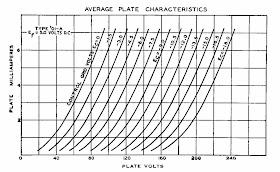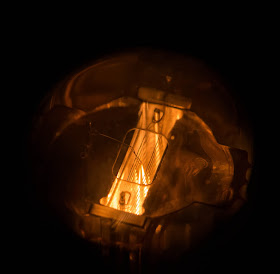This months tube is a very special directly heated triode which is among my few all time favourites. Since I started this blog, I was looking forward to present this tube, so get prepared for many photos. It is a very old tube, which was introduced in the 1920ies. The UX201A.
The UX201A was among the very first tubes which got marketed by RCA. They started with the UV200 and UV201. The latter was replaced by the UX201A in 1925.
 The UX201A differs from it's predecessors in the base. It uses the standard UX4 base. The pinout is pictured on the left. It has a thoriated tungsten filamentary cathode which runs at 5V and 250mA. The UX201A was used as detector and amplifier tube in radio sets. See the datasheet for all technical parameters. With it's low transconductance of a measly 800 micromhos combined with a low amplification factor of 8 it seems rather useless in tube audio circuits nowadays since there are plenty of more modern tubes available which have much more interesting technical properties. But used in the right way this tube can produce some very detailed and marvellous sounds. Eric Barbour once wrote an interesting article in the Glass Audio Magazine about the use of the UX201A in line stages. He wrote a very true statement: 'In a sane world there would be more tubes like the UX201A'.
The UX201A differs from it's predecessors in the base. It uses the standard UX4 base. The pinout is pictured on the left. It has a thoriated tungsten filamentary cathode which runs at 5V and 250mA. The UX201A was used as detector and amplifier tube in radio sets. See the datasheet for all technical parameters. With it's low transconductance of a measly 800 micromhos combined with a low amplification factor of 8 it seems rather useless in tube audio circuits nowadays since there are plenty of more modern tubes available which have much more interesting technical properties. But used in the right way this tube can produce some very detailed and marvellous sounds. Eric Barbour once wrote an interesting article in the Glass Audio Magazine about the use of the UX201A in line stages. He wrote a very true statement: 'In a sane world there would be more tubes like the UX201A'.The datasheet reveals some very linear plate curves as is typical for directly heated triodes:
A cross check with an actual tube on the curve tracer confirms the linearity:
I have used this tube in line stages or simply as buffer stage. It has some very special sound characteristics. Definitely on the euphonic side but in a subtle way which does not impact resolution. More about this in upcoming articles about a project with this tube.
Also check out the Reverse Time Pages for additional information about this family of tubes.

 From the 1920ies to the early 1930ies the tube was built in the beautiful globe shape. There had been a myriad of small tube manufacturers who built this or similar tubes. Some had chosen slightly different type nominations. Construction styles varied from manufacturer to manufacturer. Some had short bases some taller bases. Later the tube was manufactured in the more modern ST shape like other tubes as well. While the globe versions where rather small compared to output triodes like UX210 or UX245. The ST versions had the same size bottle as the 45 output tubes.
From the 1920ies to the early 1930ies the tube was built in the beautiful globe shape. There had been a myriad of small tube manufacturers who built this or similar tubes. Some had chosen slightly different type nominations. Construction styles varied from manufacturer to manufacturer. Some had short bases some taller bases. Later the tube was manufactured in the more modern ST shape like other tubes as well. While the globe versions where rather small compared to output triodes like UX210 or UX245. The ST versions had the same size bottle as the 45 output tubes.Let's have a look at some tube samples from different manufacturers. We start with the RCA Radiotron UX-201-A:
These got packaged in one of the most beautiful tube boxes. The tube is wrapped for additional protection inside and comes with a paper insert with information:
The dark spot with the rainbow colored border is very typical for these tubes. This is no sign of a worn tube and is present in many unused tubes. This was caused by the getter activation process during manufacturing.
The RCA Radiotron UX-201A in a different style package:
Beautifully engraved base:
The top flaps of the boxes:
Cunningham named the tube CX-301-A:
All sides of the Cunningham box:
These also came with a paper inserted.
The tube in all it's glory:
In the old days, tubes often got stickers from the shop which sold them:
Or from testing:
The Cunningham logo on the top:
The tube can be found in different sizes, even from the same manufacturer:
RH-201-A from Perryman:
Triad T-101-A:
This one got plastered with labels:
Silvertone:
This one has the entire glass covered with getter:
The base:
Arctutus 101A with blue glass:
The boxes:
The engraved base:
Let's have a look at the more modern types with ST-glass. The naming was changed to 01A when the globe shape got dropped.
Philco 01A:
Sylvania:
Another Sylvania in military JAN packaging:
National Union 01As in pristine boxes:
Engraved base:
Silvertone:
RCA 01A:
You can be sure the tube is NOS when it has the box still sealed like this:
Guarantee, licence notice and patents printed on the inner protective carton:
Engraved base:
Tube type printed on the glass:
Some photos of the predecessor of the UX201A, The UV201:
These had the older UV4 base with shorter pins than those on the UX4.
These tubes were marketed by RCA under the Radiotron brand. The manufacturer was General Electric. The GE label is barely visible:
Now let's examine how the tube is constructed. Of course I used a non functional tube with open filament. First the base is removed:
The cement which glues the glass into the base is often loose in such old tubes. Desoldering the pins and a little force gets the glass body off.
Breaking the glass dome:
These old tubes used a magnesium getter which unlike the barium getter which was used in later tubes reacts more slowly. So the silver coating does not turn white immediately as with other tubes when the glass is broken.
The internal structure:
Surprisingly the alignment of the structure is done with a triangle shaped mica disc. Other tubes of this era used glass stems.
The small wire in the middle at the top holds the filament. Since the filament was already broken, none of it is visible in this photo:
Close ups of the filament hook:
Removing the plate:
A close up showing a remainder of the filament. It is very thin, much thinner than the grid wires:
No wonder that the most common failure of UX201A is open filament. This is a very fragile tungsten wire. I opened another tube sample to get some better pictures of the filament and how it is welded to the support rod:
Another view:
And now some photos of glowing tubes:
Since most of the UX201A tubes have almost the entire glass covered with getter, glow is often only visible near the base.
This one has a bit less getter:
A glowing ST 01A:
View from the top:
ST 01A at night:
The blue Arcturus 101A in operation:
UV201 in operation:
The older UV201 had pure tungsten filaments which glowed almost white.
A view from the top:
At night the logo on the top is beautifully illuminated by the filament:
And the label as well:
I hope you enjoyed this tube presentation as much as I did when I wrote it. Of course a project with this tube will be shown soon. Stay tuned.
Best regards
Thomas




























































































I certainly enjoyed it.
ReplyDeleteWhat is the Sound Processor?
TonyB
Hi Tony
ReplyDeleteI will introduce the Sound Processor in an upcoming article
Thomas
Superb photos, thanks for sharing.
ReplyDeleteI appreciated your diligent work in all this Site :DD
Fascinating article. Thank you very much!!!!
ReplyDeleteThank you for a great article / site! The photography is fantastic as well.
ReplyDeleteAmazing. Great job. Besides the very helpful technical information, it's a pleasure to know I'm not the only one who finds history and beauty in vacuum tubes.
ReplyDeleteAwesome have many of these I got in the 70s I was young then but appreciate all those trf and regen sets
ReplyDeleteVery nice
ReplyDelete